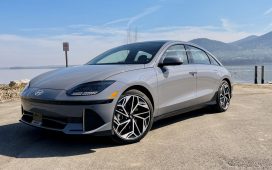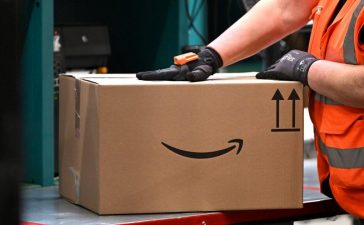Google announced a slew of new features that will be available to cars with native Android software, including YouTube, Waze, and video conferencing apps like Zoom, Microsoft Teams, and Webex by Cisco. Video games are coming to Android-equipped cars. The company also announced plans to create an “Android for Car Apps Library” for third-party developers to build their own apps for Android-equipped cars.
But the announcement that streaming video and virtual meeting tools are coming to infotainment screens is sure to pique the most interest among Android users.
Google teased the ability to watch YouTube videos while sitting in your parked vehicle last year. Now, the company is saying the feature will be available “in the coming weeks” starting with Volvo and Polestar vehicles. Other automakers will follow in short order.
To clarify, this is a feature that will only be accessible to vehicles with Google built-in, which the company describes as cars with Android’s operating system embedded natively. Cars with Google built-in can access Android apps directly from the infotainment screen and receive over-the-air (OTA) software updates as well.
So far, the list of automakers who are releasing cars with Google built-in is relatively short — but it’s also growing. In addition to Polestar, companies releasing cars with native Android operating systems include Volvo, Chevy, GMC, Cadillac, Renault, and Honda. Ford has also said it would release vehicles with re-skinned versions of its Sync operating system running on top of Google’s native Android software.
Also, Google is letting its automotive partners make the decision as to whether they want to offer YouTube to their customers, noting that the streaming video service is “now available for car makers to offer in cars with Google built-in.”
Starting with Volvo and Polestar vehicles
In addition to YouTube, cars with Google built-in are also getting video conferencing tools like Zoom, Microsoft Teams, and Cisco Webex — but only through audio, whether the car is parked or moving. Most vehicles today don’t have in-cabin cameras that can record drivers and passengers for video conferencing, or if they do, those cameras are used exclusively for driver monitoring systems.
Some automakers have been allowing customers to use in-cabin cameras for video conferencing. Tesla started rolling out Zoom functionality late last year, and the new 2024 Mercedes-Benz E-Class also includes video conferencing capabilities. Google wouldn’t comment on whether it expects cars with native Android software to have access to in-cabin cameras for video conferencing.
Audio-only conferencing and YouTube streaming videos while parked signal that Google is taking driver distraction seriously as it rolls out these new features, said Roshan Khan, director of product management at Google.
“That complexity of handling driver distraction, it’s a really high burden,” Khan said in an interview with The Verge. “And actually, you know, a lot of developers don’t know how to navigate the nuances of that.”
Distraction is a major problem for modern drivers, especially as infotainment systems become flashier and more complicated. A recent study found that drivers selecting music with Apple CarPlay or Android Auto had slower reaction times than those who were high from smoking pot. Google has been trying to work its way through this problem for several years now, but they have yet to arrive at a definitive solution.
“That complexity of handling driver distraction, it’s a really high burden.”
Khan argued that Android’s in-car products, like Android Auto, Google built-in, and Android Automotive, help ensure that third-party app developers adhere to Google’s standards for safety and reducing distraction, while also allowing leeway for the automakers to make changes to conform to their safety standards.
“And so that allows the developer, Google, and the automaker to kind of all play a role without having to absorb all of the complexity of driver distraction just purely on the developer,” he said.
That said, Khan said he could envision a future in which some of these new services, like YouTube and video games, become accessible while the car is in motion.
“We do believe that that will segue or transform into passenger experiences as cars evolve,” he said, “as you see more screens that are on the passenger side of the car or in the rear seat.”
The news that Waze, the Google-owned navigation app, is coming to cars with Google built-in is being framed as good news for EV owners in particular. Waze has been updating its feature offerings to better accommodate electric vehicles, including adding EV charging stations and using Waze’s crowd-sourcing community to offer more real-time updates about charger availability and functionality.
Google is also making more tools available to third-party navigation apps so they can access the digital gauge cluster for turn-by-turn instructions. Developers will also be able to access car sensor data to offer notifications about range, fuel level, and speed.
“We do believe that that will segue or transform into passenger experiences as cars evolve”
Lastly, cars with Google built-in are getting more video games through the Google Play Store, including Beach Buggy Racing 2, Solitaire FRVR, and My Talking Tom Friends from publishers like Vector Unit, FRVR, and Outfit7.
Until recently, most automakers have been reluctant to add video games to their cars’ infotainment screens. Tesla has a wide range of video games available to its customers, including popular titles like Sonic the Hedgehog, Stardew Valley, and Cuphead. Google’s list of games is not nearly as popular, but it is a sign that the dam may be about to break in terms of video games being available in people’s cars.
Android Auto has offered video games through its phone projection service for over a year now, and Khan said the team was surprised at how popular they were, with over 1 million active users. But ultimately, these will be part of the “parked experience” and will be unavailable while the car is in motion. (Tesla infamously and briefly allowed its customers to access video games while driving before eventually disabling the feature.)
Interestingly, in its press materials, Google rightly notes that people are spending way more time in their cars than they ever have before, citing a AAA study that found that Americans spent a total of 70 billion hours behind the wheel in 2019. It’s a crisis created by our car-centric world, facilitated by poor urban planning, suburban sprawl, and road designs that actively prevent more active mobility solutions, like biking and walking.
And now, here comes Google to give us more stuff to play with while we’re trapped in our cars. Khan notes that customer preferences are changing, so Android is changing to suit those preferences.
“As demographics shift, we’re getting new people who are driving cars who grew up just always having access to applications and the internet and these types of things,” he said. “And it’s strange to them to be in a car where they’re disconnected.”












